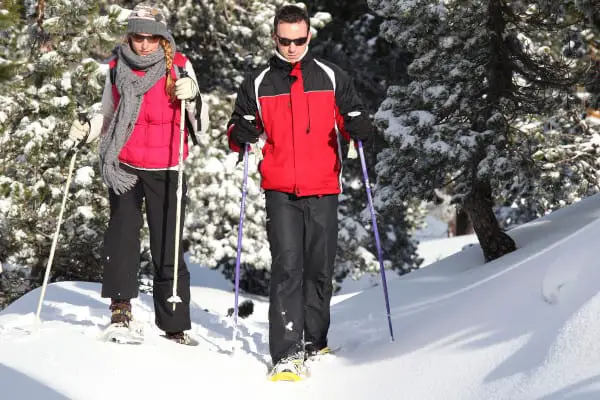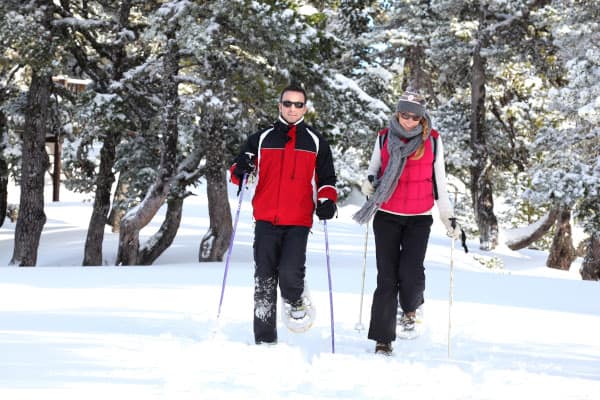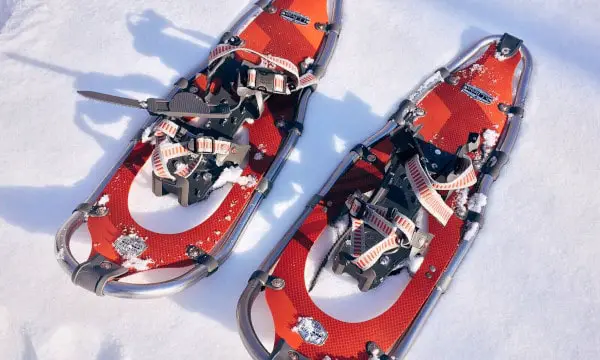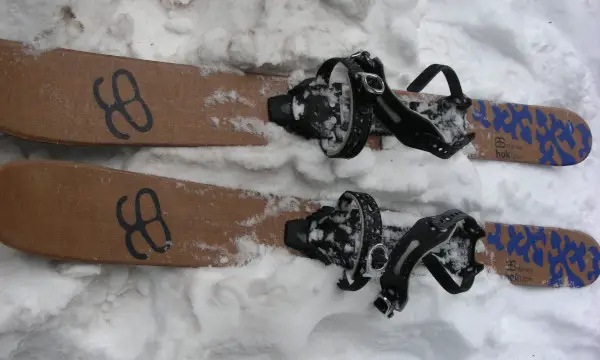Table of Contents
If you are just starting off with snowshoeing, there are some basic techniques that you should definitely know.
Basic Snowshoeing Techniques
The following techniques are the most basic snowshoeing techniques one must know before getting out intro the backcountry. Most of these can be learned within an hour, while others require more practice.
Get into your hiking boots, put on your snowshoes, and let’s go snowshoeing!
1. How to Get Up with Snowshoes
While snowshoeing, you may inevitably fall in the snow, at which moment you will realize that standing up again isn’t as simple as it seems. Therefore, first and foremost, you should learn to get up after falling in the snow.
- A simple approach includes rolling over onto your front, getting on one knee, and placing the other at a 90° angle.
- Then place your hand on the knee in front and push yourself up till you’re in a standing position.
- If you have friends accompanying you, take their support as you stand.
Another method is to use your poles to get up get up. You should definitely learn this if you are to snowshoe in deep powdery snow.
- Simply overlap your ski poles to make an X.
- Put your hands at the point where the poles meet.
- Now, push and try to stand up.

2. How to Walk in Snowshoes
Walking forward in your snowshoes is known as striding. The basic technique is to keep your stride natural. It should be compatible with the snowshoer’s step. However, keep your legs a little wide apart to avoid kicking your shins.
Walking and running on flat terrain should feel natural, so modifying or exaggerating your gait is unnecessary. Also, too much straddling can result in muscle pain, mainly in your thighs. For this, we recommend doing some exercises before actually going onto snow.
It’s important that if you meet any groomed trails for cross-country skiers, avoid stepping and ruining those. You should head to multi-use or specific snowshoeing trails, if you are not yet ready to go into the wild.
3. How to Break Trail with Snowshoes
Breaking trail refers to making way in untouched snow, possibly in the backcountry. A person leading the group has to break the trail and make a track through the snow. It is not an easy task, and the snow’s depth determines the amount of effort required to get through it.
When breaking trail, you should move slowly, lift higher steps and press the snow under your snowshoes to make a solid shelf of snow for the others following you.
If you are in a group, switch places leading every few minutes so that everyone can put effort into this demanding task. It will give every group member a chance to have a break and rest while maintaining a pace over the trail.
4. How to Ascend in Snowshoes
Moving uphill in snowshoes requires some advanced techniques and practice. Hiking poles are one of the valuable accessories you need while ascending hills, but make sure your poles have snow baskets than simple hiking pole baskets.. Place your feet firmly on the snow and use the toe for traction with the pole in front of you. There are three well-accepted approaches for snowshoeing uphill.
A) Side Stepping
While climbing a steep slope, you will find maximum stability in the side stepping technique.
- Position your body perpendicular to the hill.
- Take sideward steps as you move up the hill.
- Edge your uphill foot to make a shelf or step, and then follow with the downhill foot.
- Climb up in the same fashion slowly.
B) Herringbone Stepping
The herringbone step works well for moderate hill climbing.
- Turn your snowshoes out at a 45° angle and face uphill.
- Now place your weight on the outside of the snowshoe to dig into the snow.
It will give you the required stability and traction as you move up.
C) Kick Stepping
Another technique that works best in deep snow on steep ascents is kick-stepping. This approach is often used in higher mountains to travel upwards. It’s all about kicking, pausing, and stamping the snow.
- Pick your foot up and kick the toe of your snowshoe into the snow
- Pause, and stamp to build steps.
- Make sure the snow solidifies properly to prevent collapsing snow shelves.
5. How to Go Downhill on Snowshoes
Descending a hill can be a little more complicated than ascending. However, proper snowshoeing gear and skills can help you come down easily.
Make sure to adjust your snowshoe poles to be a little longer for the descent.
A) Down-Hilling
- Bend your knees and relax while leaning back slightly.
- Depending on the slope’s angle, put weight on the shoe with some shift to your heel.
B) Step Sliding
Step sliding or Glissading is another descending technique for moving down a hill quickly.
- Keep your body weight on the heel.
- Run down fast using long strides.
- Make sure to assess the terrain ahead to check if it’s clear of any obstruction.

6. How to Traverse on Snowshoes
Traversing, also known as side-hilling, takes you uphill at an angle. It is one of the most common methods of traveling on snow, as it avoids steep climbs by accessing an alternative route to get up the hill.
Keep your weight on the uphill snowshoe and kick into the slope to create a shelf as you move forward and upward.
7. How to Turn Around on Snowshoes
Turning around on snowshoes is another basic technique. The simplest way to do this is by walking in circles. However, there may be a situation where space and time won’t allow this approach. Therefore, an excellent alternative to running around is a step turn that involves the following:
- Position one foot at a 90° angle in front of the other.
- Then shift your body to bring the other foot to meet the first.
- Repeat the steps to make a complete turn.
8. How to Snowshoe in Deep Snow
Snowshoeing in deep snow requires you to tread lightly and pace yourself. Keeping your balance is the key in this case.
Carefully lift your heels and shorten your strides to make way through the snow. It is recommended to pick the next largest size snowshoe as it improves your floatation in deep drifts.
9. How to Get Over Obstacles
While ascending or descending, you are bound to find a few obstacles on your way. Sometimes steep slopes can be too dangerous to climb. Other times, there may be ledges or even a fallen tree trunk that will require some extra work on your part. Trekking poles can provide better balance as you try to go over the obstacle. Just lift one foot over the obstacle, place the trekking pole securely, and bring the other foot along.
10. How to Run in Snowshoes
If you are planning to run on terrains in snowshoes, you will first need specific running snowshoes for the purpose. These are narrower and lighter than most snowshoes. Also, wear water-resistant pants, as you will be kicking up snow and splattering it all over the back of your legs while running.


